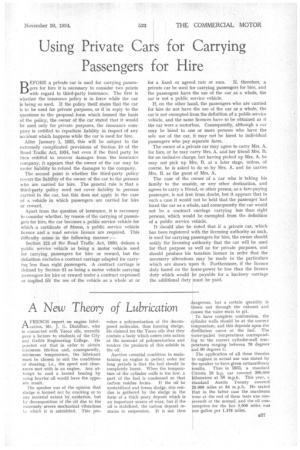Using Private Cars for Carrying Passengers for Hire
Page 55

If you've noticed an error in this article please click here to report it so we can fix it.
BEFORE a private car is used for carrying passengers for hire it is necessary to consider two points with regard to third-party insurance. The first is whether the insurance policy is in force while the car is being so used. If the policy itself states that the car is to be used for private purposes, or if in reply to the questions in the proposal form which formed the basis of the policy, the owner of the car stated that it would be used only for private purposes, the insurance company is entitled to repudiate liability in respect of any accident which happens while the car is used for hire.
After January 1, 1935, this will be subject to the extremely complicated provisions of Section 10' of the Road Traffic Act, 1934, but even if the third party be then entitled to recover damages from the insurance company, it appears that the owner of the car may be under liability to refund the damages to the company.
The second point is whether the third-party policy covers the liability of the owner of the car to the persons who are carried for hire. The general rule is that a third-party policy need not cover liability to persons carried in the car, but this does not apply in the case of a vehicle in which passengers are carried for hire or reward.
Apart from the question of insurance, it is necessary to consider whether, by reason of the carrying of passengers for hire, the car becomes a public service vehicle for which a certificate of fitness, a public service vehicle licence and a road service licence are required. This difficulty arises in the following manner :—
Section 121 of the Road Traffic Act, 1930, defines a public service vehicle as being a motor vehicle used for carrying passengers for hire or reward, but the definition excludes a contract carriage adapted for carrying less than eight passengers. -A contract carriage is defined by Section 61 as being a motor vehicle carrying passengers for hire or reward under a contract expressed or implied far the use of the vehicle as a whole at or
for a fixed or agreed rate or sum. If, therefore, a private car be used for carrying passengers for hire, and the passengers have the use of the car as a whole, the car is not a public service vehicle.
If, on the other hand, the passengers who are carried for hire do not have the use of the car as a whole, the car is not exempted from the definition of a public service vehicle, and the same licences have to be obtained as if the car were a motorbus. Consequently, although a car may be hired to one or more persons who have the sole use of the car, it may not be hired to individual passengers who pay separate fares.
The owner of a private car may agree to carry Mrs. A. for hire, or he may carry Mrs. A. and her friend Mrs. 13. for an inclusive charge, but having picked up Mrs. A. he may not pick up Mrs. B. at a later stage, unless, of course, he is asked to do so by Mrs. A. and he carries Mrs. B. as the guest of Mrs. A.
The case of the owner of a car who is taking his family to the seaside, or any other destination, and agrees to carry a friend, or other person, as a fare-paying passenger, is not free from doubt, but it appears that in such a case it would not be held that the passenger had hired the car as a whole, and consequently the car would not be a contract carriage carrying less than eight persons, which would be exempted from the definition of a public service vehicle.
It should also be noted that if a private car, which has been registered with the licensing authority as such, is used for carrying passengers for hire, the owner should notify the licensing authority that the car will be used for 'that purpose as well as for private purposes, and should produce his taxation licence in order that the necessary alterations may be made in the particulars which are shown upon it. Furthermore, if the licence duty based on the horse-power be less than the licence duty which would be payable for a hackney carriage the additional duty must be paid.




































































































